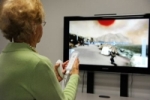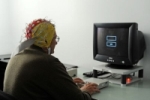Projects
Adult Age-Related Changes in Selective Attention and Visual Search
 What are the cognitive processes responsible for locating items in the visual environment? For example, how does one find a friend in a crowd, a car in the parking lot, or a favorite candy bar from the grocery shelf? We are interested in determining the cognitive processes that assist in visual search, and the manner in which these processes change with age.
What are the cognitive processes responsible for locating items in the visual environment? For example, how does one find a friend in a crowd, a car in the parking lot, or a favorite candy bar from the grocery shelf? We are interested in determining the cognitive processes that assist in visual search, and the manner in which these processes change with age.
Evidence suggests that older adults search visual scenes less efficiently than younger adults, but the mechanisms responsible for these age-related changes are still unclear.
Cognitive Training using Video Games
 Are video games simply a fun way to pass the time, or could they help improve cognitive skills? Recent research suggests that video game training improves the attention abilities of younger adults (e.g., Green & Bavelier, 2003).
Are video games simply a fun way to pass the time, or could they help improve cognitive skills? Recent research suggests that video game training improves the attention abilities of younger adults (e.g., Green & Bavelier, 2003).
Video games are known to be visually and cognitively demanding, as multiple items must be tracked and processed in a detailed environment. We are interested in how video game training impacts older adults' attention abilities as well as their driving performance, daily functioning, and well-being.
In our study, participants complete multiple sessions playing a video game on a Nintendo Wii game system. Before and after training, participants complete a variety of questionnaires and paper-and-pencil tasks, computerized tests of attention, and a driving simulator task.
Driving and Aging
 In collaboration with the Upper Great Plains Traffic Institute at North Dakota State University, we are conducting studies to investigate how driving performance changes with age, and whether various environmental manipulations (e.g., sign placement) enhance driving performance.
In collaboration with the Upper Great Plains Traffic Institute at North Dakota State University, we are conducting studies to investigate how driving performance changes with age, and whether various environmental manipulations (e.g., sign placement) enhance driving performance.
In the simulator lab, we compare the performance of middle-aged and older adults as they sit in a car and "drive" interactively in different computer-simulated driving scenes (e.g., daytime and nighttime driving, high and low traffic levels).
Attention, Aging, and Brain Imaging
 Does brain activity associated with attention change with age?
Does brain activity associated with attention change with age?
Using a non-invasive electrophysiological brain-imaging technique called ERP (event-related potential) recording, we are able to measure electrical activity naturally generated by the brain. A special cap is worn while participants complete computer tasks of attention. We are interested in whether the timing of certain brain activities, and the involvement of different brain areas, changes with age.
Attention, Aging, and Emotion
 We process emotional information differently than non-emotional information. For example, we are quicker to notice threatening information in the environment (e.g., a growling dog) than non- threatening information (e.g, a purring cat). We are also more likely to remember emotional facts rather than neutral facts from a story. We are interested in how aging influences cognitive processing of emotional information.
We process emotional information differently than non-emotional information. For example, we are quicker to notice threatening information in the environment (e.g., a growling dog) than non- threatening information (e.g, a purring cat). We are also more likely to remember emotional facts rather than neutral facts from a story. We are interested in how aging influences cognitive processing of emotional information.
Later adulthood is thought to be accompanied by a greater emphasis on emotionally meaningful goals and emotionally rewarding relationships. As a result, older adults may attribute greater importance than younger adults to the affective content of information, thus impacting attention to and memory of such information.
Funding Sources
Langley, L. K. (PI) and Gordon, R. D. (Co-I). National Science Foundation (NSF) ADVANCE Leap Grant. “Video Game Training to Enhance Cognition and Functioning in Older Adults.” HRD-0811239, 9/09-2/11. $25,000.
McCourt, M. E. (PI), Langley, L. K. (PD), Gordon, R. D. (PD), and Friesen, C. K. (PD) NIH ARRA Administrative Supplement to Advance Translational Research. “Video Game Training to Enhance Visual Cognition and Everyday Functioning in Older Adults.” 10/1/09-9/31/11, $948,383.
Johnson, K. (PI), Vachal, K. (Co-I), Langley, L. (Co-I), McCourt, M. (Co-I), Gordon, R (Co-I), and Brady, M. (Co-I). Federal Highway Administration, University Transportation Centers Program, DTRT07-G-0008, “Rural Road Signage: Simulated Driving to Evaluate Low-Cost Safety Improvements for Older Drivers,” 7/1/08-6/30/11, $110,000.
Mark McCourt (PI/PD), Chris Friesen (PD), Robert Gordon (PD), Linda Langley (PD), and Mark Nawrot (Co-I). National Institutes of Health (NIH) Centers of Biomedical Research Excellence (COBRE). “Center for Visual Neuroscience.” 9/20/04-9/19/09, $8,920,000. [Individual project: “Inhibition and Age-Related Changes in Visual Search”; Individual budget: $663,000]
